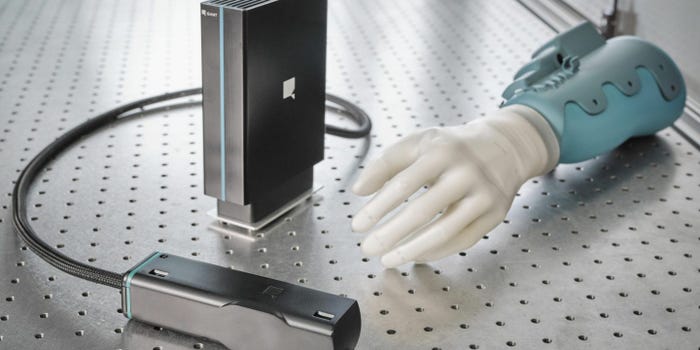IoT technologies could help law enforcement and security officials fight back against mass shootings, but stopping snipers may be impossible.
October 4, 2017

When Stephen Paddock opened fire on a crowd at a concert from his hotel room on the 32nd floor on Sunday night in Las Vegas, it took police 72 minutes after the first 911 call to find the sniper, who would go on to perpetrate the deadliest mass shooting in U.S. history.
There appear to be few ready-made technological options that could have single-handedly thwarted the shooting. And there are trade-offs between cost and privacy when it comes to using technology to improve physical security. But the issue is an important one to consider. In the 477-day span between the 2016 Orlando, Fla., nightclub shooting and the most recent mass shooting in Las Vegas, there have been 521 mass shootings, as The New York Times recently observed.
Gunshot detection systems working in tandem with video surveillance and IoT-based and traditional security technologies could at least mitigate the damages of such attacks.
“The power of a single security technology starts to increase exponentially when you combine it with other technology,” said Don DeLoach, co-author of “The Future of IoT: Leveraging the Shift to a Data Centric World.” But DeLoach also acknowledged the inherent difficulties involved in this case. “You could link [technology such as a gunshot detection system] to a public awareness and notification system, enabling you to do geolocation against where the shots are coming from and send a message to everybody’s phone letting them know something is going on,” he said. “But in this case, you had 22,000 people hemmed in at a concert, so getting them a notification on their phones that there are shots fired isn’t going to do you any good.”
Here, we take a look at the smart building technology suitable for mass shootings and describe their strengths and weaknesses.
Spotting the weapons before attacks begin
In preparing for the assault, Paddock managed to smuggle 23 rifles, two tripods and hundreds of rounds of ammunition into his hotel room on the 32nd floor. Because Paddock hid the weapons in at least 10 suitcases, it probably would have been difficult to detect him smuggling the weapons into the hotel without deploying metal detectors or X-ray scanners. While some hotels in India and the Middle East and Africa have such technologies, they are largely absent in the United States, where they could interfere with hotel guests’ hospitality expectations for hotel. Once in the room, Paddock could have kept housekeeping away by simply hanging a do-not-disturb sign on the door.
There is the possibility of using video surveillance in hotel rooms. While this could have spotted the weapon cache in Paddock’s hotel room, deploying cameras in hotel rooms would not likely be a popular option with the public. “You would have to have tremendous trust for someone to go into a hotel room where there is a camera that could be activated,” DeLoach said. “Everybody’s first thought is: ‘Is there something nefarious going on with this hotel?’ And their second thought is: What if someone hacks the camera?”
[Smart Cities Summit is the go-to event for government and technology executives mapping America's smart cities. Visit the site to learn more about the agenda, speakers and networking opportunities.]
Another video-based option would be using video analytics to analyze the behavior of guests in public spaces within the hotel. Because Paddock brought in at least 10 suitcases into his room, a sophisticated video analytics system could theoretically create a security alert based on his anomalous behavior, although it would need accurate facial recognition capabilities as well. Another option would be to use video analytics with the intent of identifying weapons such as rifles that may be hidden in luggage. This functionality, however, would likely be difficult to accomplish considering the massive amount of data processing capability it would likely requiring.
Identifying smashing glass
Once in his hotel room, Paddock smashed holes into two windows to fire at the crowd of 22,000 people below. If smart building technology such as glass-break sensors were deployed in the room, they could have sounded an alarm enabling police to reach his room quicker. Police began their search for the sniper on the 29th floor and worked their way upward. “A glass-break detector can pick up breaking glass about 15 to 20 feet away, but I don’t know how feasible it is for a hotel,” said Cameron Javdani, director of sales and marketing at Louroe Electronics, which offers both glass-break sensors and gunshot detection systems. “Would Mandalay Bay want to put a glass-break detector in each of the roughly 3,300 rooms at the hotel? Beyond that, would hotel guests be comfortable with the thought of a microphone in each room, even if it was there only to pick up glass-breaking sounds?”
Shock-based sensors are also available, although they are designed more for keeping burglars out than prohibiting a sniper from smashing a window and shooting through the opening.
Pinpointing gunshots
Advanced gunshot detection implementations could determine the elevation of the shooter in addition to providing police information on the time the shooting began and could also track the number of rounds fired. The level of ambient noise involved with the outdoor concert could have proven to be a challenge in the Las Vegas shooting, explained Javdani. It was also difficult for many concertgoers to determine the origin of the gunfire; some people at the event first thought the shots were fireworks.
“For an outdoor situation like this, it matters how far away and how loud the gunshot is compared to the ambient environment,” Javdani said. A gunshot detector that was on the ground at the concert would likely pick up the music in the foreground and the gunshots in the background. “The first parameter [for gunshot detection systems] is that you hear a loud noise above the ambient noise,” Javdani added. “If you had a sensor nearby the window [where the sniper was] during the concert, you are going to pick up that gunfire. When we are designing out a system, we are very cognizant of whether we are indoor or outdoor and the potential sound reflections. If we are talking about [whether we] could … have picked up this incident on Sunday, the answer is: It depends. Where would the sensor be installed and what was the ambient noise around the sensor?”
A growing number of IoT devices come bundled with sound detection capabilities and some hotels, such as Marriott, are testing using Amazon’s Alexa-powered Echo in hotels. In the future, it might be possible that a range of IoT and smart building technology could help listen for gunshots and automatically alert authorities, but this remains an abstract possibility at this point.
The most widely deployed system for detecting sniper fire is known as Boomerang, which was developed by DARPA and Raytheon subsidiary BBN Technologies. A cluster of seven microphones, the Boomerang leverages a computer to identify the location of a sniper — including elevation relative to the device. Deployed on the back of Humvees in Iraq and Afghanistan, the Boomerang will not sound false alarms when it picks up fireworks, door slams and other loud noises, and it is one example of the types of gunshot detection systems deployed in the United States to thwart mass shootings.
Detecting gun smoke
When Paddock fired roughly nine rounds per second at the audience of concertgoers below, his hotel room filled with smoke, sounding a fire alarm that enabled the SWAT team to home in on his position in about 20 minutes, according to the Washington Post. Each time a shot is fired, plumes of smoke, soot and gunpowder stream from the barrel.
A system of systems approach
In the future, we could see cities deploy comprehensive security systems leveraging smart city technology with a wide range of functionality. This could trigger an alarm to the various people nearby — whether the public or hotel managers — and enable, say, streetlights, parking lot lights, city-mounted cameras and traffic systems to all work together. “Let’s say the shots just went off from the 32nd floor of the hotel. You want to notify the police and you want to illuminate where the shots are coming from,” DeLoach said. “You could take down all of the lights outside of that area, so the shooter no longer has as clean of a shot.”
In this scenario, the system could give a signal for cameras to focus on the shooter. “This does two things,” DeLoach said. “It captures valuable information for the police, but the other thing is you can start to broadcast 45 seconds from the time the shots were going off, you have lit up the area, reduced lighting elsewhere, and you started broadcasting a feed of the shooter.”
In the future, alarm scenarios could also trigger modifications in a smart city’s infrastructure.
“You can also do things to connect the signal to open up the traffic lane so you give priority to first responders,” DeLoach explained. “In a hotel, if there is a shooter, you probably want to lock down the rooms.”
A forward-looking security strategy, however, will investigate not just how to thwart mass shootings, but seek to identify other potential types of attack, whether they be from explosives or hackers, and also consider who controls the high-tech technology designed to detect mass shootings. “If IoT is the monitor and detector technology, it's worth asking: Who’s the monitor of the monitors?” said Peter Tran, RSA's Advanced Cyber Defense general manager and senior director. Maintaining the integrity of IoT-based surveillance technologies requires keeping tabs on them to ensure they are in working order. “For example, a sophisticated actor in the smart city would first subvert and disrupt the IoT grid or perform sensor interrupts to spoof data into the IoT monitoring zone,” Tran said. “For every move, there’s a countermove.”
Already, the hotel industry is beginning to reassess their protocols to more effectively deal with similar situations in the future, whether it comes down to working to prevent them or mitigate damages once a shooting begins. While the former is preferable, it may be difficult to accomplish, said Chris Kocher, co-founder of the consulting firm Grey Heron.“When someone starts shooting, it is already too late,” he explained. “Preventative strategies, however, tend to impact individual privacy and civil rights, which is why we as a society have not been able to do much with licensing and regulating guns in any way.”
About the Author(s)
You May Also Like


.png?width=700&auto=webp&quality=80&disable=upscale)
.png?width=300&auto=webp&quality=80&disable=upscale)


.png?width=300&auto=webp&quality=80&disable=upscale)